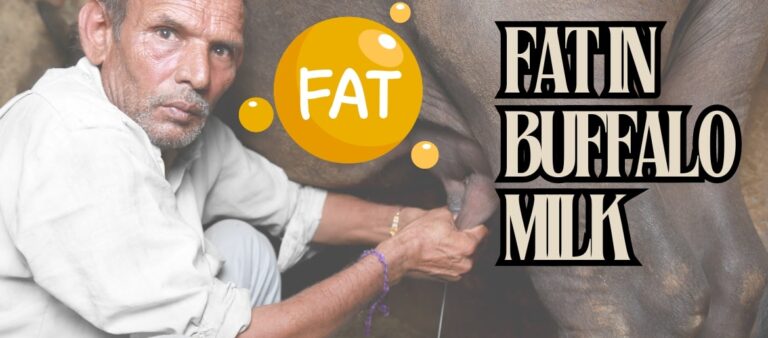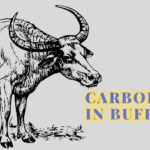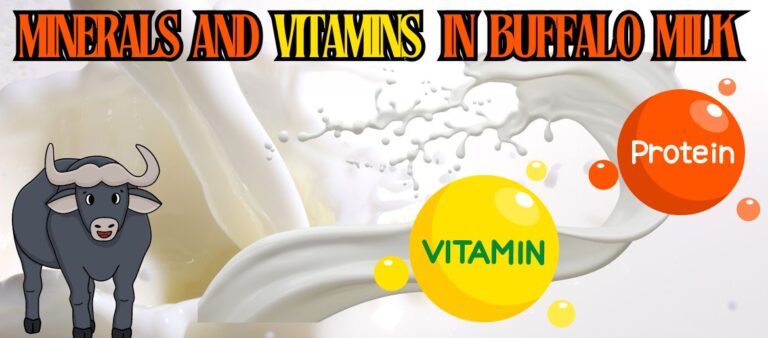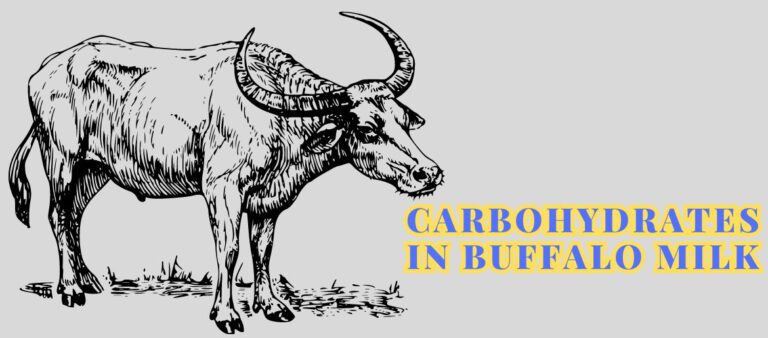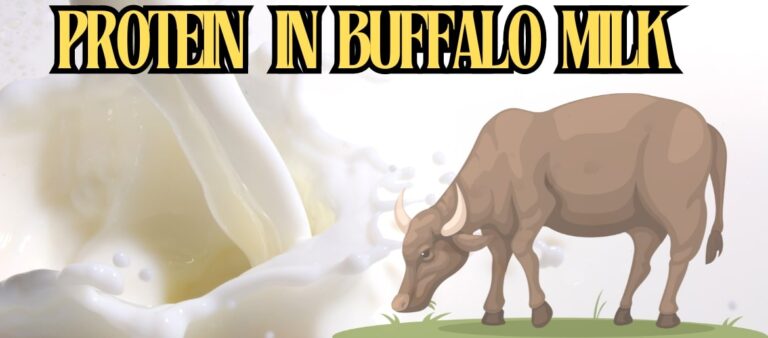Hey there! Have you ever tried the creamy goodness of buffalo milk? It’s a nutrient-rich delight cherished in places like India and Pakistan, where it’s turned into all sorts of delicious treats like butter, yogurt, cheese, and ice cream.
Buffalo milk is famous for its rich, creamy texture thanks to its higher fat content. At about 6% to 7% fat, buffalo milk is more prosperous than cow’s milk, which makes it taste like you’re sipping a milkshake straight from the glass.
buffalo milk vs Cow Milk
Let’s take a closer look at how buffalo milk stacks up against cow’s milk:
| Nutrient | Buffalo Milk | Cow’s Milk |
| Calories | 237 | 149 |
| Protein | 9g | 8g |
| Fat | 17g | 8g |
| Lactose | 13g | 11g |
| Calcium | 32% DV | 21% DV |
Buffalo milk packs more protein, fat, and lactose than cow’s milk. Plus, it contains essential vitamins and minerals like phosphorus, magnesium, and vitamin A.
In every 100 ml of buffalo milk, you’ll find about 6.89 grams of fat, 97 calories, and 3.75 grams of protein. This rich fat content gives buffalo milk its thick texture, perfect for making butter, ghee, cheese, and ice cream. So whether you’re drinking it straight or enjoying buffalo milk-based treats, you’re in for an absolute delight!
Have you ever wondered why buffalo mozzarella tastes so heavenly? Well, it’s all thanks to buffalo milk! Compared to cow milk, buffalo milk contains much more fat, which gives it that luxurious, creamy texture we all love.
The fat in buffalo milk is genuinely remarkable. With an average fat content of 6% to 7%, buffalo milk outshines cow milk, which typically has about 3-4% fat. This extra fat adds to the creamy texture and gives buffalo milk a slightly sweeter taste.
When we compare buffalo milk with cow milk, it’s like looking at two different worlds. Buffalo milk reigns supreme in the fat department, while cow milk might have more of a beneficial fatty acid called CLA. Ultimately, it all comes down to your preference and what fits your dietary needs.
Understanding the fat content in buffalo milk can help us make informed decisions about our diets. Every liter of buffalo milk contains around 60-70 grams of fat. In a smaller portion, like 100 grams of buffalo milk, you’ll find approximately 6-7 grams of fat.
So, if you’re looking for a more prosperous, higher-fat option, buffalo milk is the way to go. But cow milk might be a better choice if you’re monitoring your fat intake. As always, consulting with a healthcare professional for personalized advice tailored to your needs is a good idea.
Strategies to Increase Fat in Buffalo Milk
Selective Breeding: One effective strategy for boosting buffalo milk fat content is selective breeding. Farmers choose buffaloes with specific genetic traits linked to fat production. By breeding these buffaloes, we aim to enhance their milk’s overall fat content gradually. This approach involves selecting parent buffaloes based on their fat yield, ensuring their offspring pass desirable traits down. Over time, this method can lead to a herd with higher fat-producing genetics.
Dietary Adjustments: Another key tactic involves making dietary adjustments for buffaloes. Providing them with a well-balanced diet to maximize fat content is essential. Buffaloes require a mix of proteins, carbohydrates, vitamins, and minerals for overall health and milk production. Including fats in their diet, such as vegetable oils or high-fat feed, can directly impact the fat content in buffalo milk. We promote better milk quality and fat synthesis by ensuring buffaloes receive adequate nutrients.
Milking Techniques: Proper milking practices are crucial for extracting the maximum fat content from buffalo milk. Buffaloes should be milked gently to avoid stress, as stress can affect milk composition, including fat content. Ensure all milk is extracted during each milking session to prevent fat loss. Effective milking techniques yield milk with consistent fat levels, enhancing overall quality.
Addressing Health Concerns
Buffalo milk offers numerous health benefits, making it suitable for various individuals:
- Who Benefits? Children: Buffalo milk provides essential nutrients for vigorous growth and development. Its higher fat content supports brain development and overall health.
- Underweight Individuals: The extra calories from buffalo milk can be beneficial for those looking to gain weight. It serves as a nutritious option to increase calorie intake.
- Traditional Medicine Enthusiasts: In some cultures, buffalo milk is revered for its perceived healing properties. It has been traditionally used to address various health issues.
- Who Should Be Cautious? Lactose-Intolerant Individuals: It’s important to note that buffalo milk contains more lactose than cow’s milk. Therefore, individuals with lactose intolerance may experience discomfort after consuming it.
- Individuals with High Cholesterol: While buffalo milk’s fat content can be beneficial, moderation is vital for those managing cholesterol levels.
Cons of Buffalo Milk
It’s essential to consider the potential drawbacks of buffalo milk:
- Lactose Intolerance: Some individuals may experience bloating, gas, or diarrhea due to buffalo milk’s higher lactose content.
- Environmental Impact: Rearing buffaloes require more water and food than cows, which can strain the environment due to increased resource usage.
Conclusion
Buffalo milk, with its high-fat content, is truly a culinary delight. Whether enjoyed independently or incorporated into recipes, it offers a rich and indulgent experience. Maintaining a balanced diet is essential, and being mindful of what you consume is paramount for overall health and well-being. Here’s to the richness and versatility of buffalo milk!
Related Posts
- Learn how enzymes in buffalo milk contribute to digestion and health.
- Discover the role of carbohydrates in buffalo milk and their health benefits.
- Understand the importance of immunoglobulins in buffalo milk for immune support.
- WELLHEALTHORGANIC BUFFALO MILK TAG: PURE, HEALTHY, ETHICAL.
- HEALTH BENEFITS OF FATTY ACIDS IN BUFFALO MILK.

